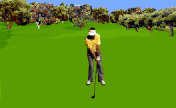By Jack Moorehouse
Golf is a thinking man’s game. Ask veteran players with low golf handicaps what they think about golf and they’ll probably agree with the preceding statement. Like many thinking men’s games, such as chess, staying two or three strokes ahead often saves you from disaster. Course management is one of those skills you pick up by playing, not by attending golf lessons or group golf instruction sessions. Those who master course management shed strokes from their golf handicaps without even using up a club.
But even the most skilled course managers can’t always control where the ball ends up once it hits the ground. Even if you’ve learned to stop the ball dead in golf lessons, you can’t always count on controlling the ball after it hits. Sometimes, you get a good lie. Other times, you get a bad lie. A lot depends on the course and the kind of day you’re having. But golfers with low golf handicaps don’t panic when the get bad lies. Instead, they let the lie dictate their shot.
Below are some poorer lies you’ll face on a course and golf tips on how to play from them. If you’re serious about lowering your golf handicap, ingrain these golf tips. They’ll save you strokes.
Normal Bunker Lies
Not all bunker lies are the same. But you can use your feet to tell what kind of lie you have and how hard the sand is beneath the ball. Get a feel for the sand as you dig your feet in for stability. If the sand is wet and firm, you’ll need a shallow angle of attack, since you want to take less sand with this shot. So open your clubface and stance slightly and aim for a spot about an inch behind the ball. If the sand is deep and fluffy, you’ll need a full explosion shot. Your clubface and stance should be wide open. Take a full steep swing to allow the club to remove plenty of sand.
Shallow Bunkers
Shallow bunkers can fool you. While the loose sand looks fluffy, there’s often a hard surface beneath it. Your clubface will bounce off this surface, resulting in a long bladed shot. Play this lie like a normal pitch shot. Square your clubface and open your stance slightly. Make a three-quarter swing and half an inch behind the ball. Stay firm through impact and into your follow-through. The ball flies out like a pitch shot that you hit slightly fat.

Muddy Lies
The tendency with muddy lies is to try to pick the ball up. This usually results in either a skulled shot or a fat shot one. Instead, cock your wrists in the back swing and hold the position for as long as you can on the downswing. Your hands will be ahead of the ball, which ensures a descending blow. Releasing your hands will cause the ball to fly low and left, if you’re right-handed. Keeping the clubface open, on the other hand, results in a straight and true shot.
Pine Straw
Not every course has pine straw. But many do. Hitting from here is similar to hitting from a fairway bunker. Don’t sole your club, which prevents you from disturbing the straw and moving the ball. Instead, hover your club an inch off the ground and stand a bit taller at address to compensate for the change. To prevent slipping, pretend you’re standing in cement. Keep your feet planted and your weight centered as you swing. This helps you steady yourself and make solid contact. Also, make thin, ball-first contact and sweep the ball off the ground, as you would in a fairway bunker, instead of swinging down on it.
This list of bad lies is not exhaustive. There are plenty more out there, like sidehill lies or hardpan lies. If you’re serious about chopping stokes off your golf handicap, keep track of the bad lies you face regularly and learn to hit from them. If you’re having trouble doing so, set up a golf instruction session with a local pro. Your game will improve greatly by learning to handle bad lies.
This entry was posted on Friday, August 27th, 2010 at 12:51 pm and is filed under Golf Articles. You can follow any responses to this entry through the RSS 2.0 feed. You can leave a response, or trackback from your own site.




No comments:
Post a Comment